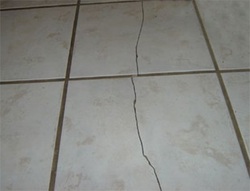
As I am installing a garbage disposer for a customer, she mentions that she will move some items from the kitchen counter top so I have more room to work. I say thank you. Two seconds later BAM! No, it's not Emeril Lagasse spicing it up a bit in the background on TV, it's my hammer.
As my customer moves thing away for me to work, she inadvertently drops my hammer onto her tiled kitchen floor and hence adding a crack to one of her floor tiles. The damage was done.
Luckily, I knew what to do. The first thing I did, and you can too if you have the tools, was to chisel out the grout around the damaged tile. Do this carefully as you don't want to damage adjacent good tile. This is done so that when you go chisel out the broken tile you don't pull up non damaged tiles. This is the same concept you see in concrete sidewalks. Have you ever noticed the lines or grooves cut into the concrete creating a series of squares or rectangles as you walk? What this does is basically stops cracks from moving beyond those points and confining the damage to a relatively small area that can be later repaired.
Anyway, after you remove the grout around the damaged tile you can begin the process of chiseling out the affected tile. Remember to remove as much of the mortar under the tile as possible. Once the mortar is removed you will need to vacuum a lot of dust and debris left over from the demolition. Home Depot, Lowes or your local home center should have replacement tile if yours aren't from the 1970's. Otherwise you may have to use a similar design or find tile from a online supplier. You can also find ready made mortar and grout mix to use to set the tile and use the same mix to grout. Several color options are available. Use a grooved spatula to spread mortar mix onto the tile. Set the tile and use a level to make sure it's level all around. After grouting, use a specialty sponge, also found at your home center to clean up excess grout. Use a diagonal stroke as opposed to wiping along the grout lines as this may cause more grout removal than needs be. And there you have it...
As my customer moves thing away for me to work, she inadvertently drops my hammer onto her tiled kitchen floor and hence adding a crack to one of her floor tiles. The damage was done.
Luckily, I knew what to do. The first thing I did, and you can too if you have the tools, was to chisel out the grout around the damaged tile. Do this carefully as you don't want to damage adjacent good tile. This is done so that when you go chisel out the broken tile you don't pull up non damaged tiles. This is the same concept you see in concrete sidewalks. Have you ever noticed the lines or grooves cut into the concrete creating a series of squares or rectangles as you walk? What this does is basically stops cracks from moving beyond those points and confining the damage to a relatively small area that can be later repaired.
Anyway, after you remove the grout around the damaged tile you can begin the process of chiseling out the affected tile. Remember to remove as much of the mortar under the tile as possible. Once the mortar is removed you will need to vacuum a lot of dust and debris left over from the demolition. Home Depot, Lowes or your local home center should have replacement tile if yours aren't from the 1970's. Otherwise you may have to use a similar design or find tile from a online supplier. You can also find ready made mortar and grout mix to use to set the tile and use the same mix to grout. Several color options are available. Use a grooved spatula to spread mortar mix onto the tile. Set the tile and use a level to make sure it's level all around. After grouting, use a specialty sponge, also found at your home center to clean up excess grout. Use a diagonal stroke as opposed to wiping along the grout lines as this may cause more grout removal than needs be. And there you have it...

 RSS Feed
RSS Feed